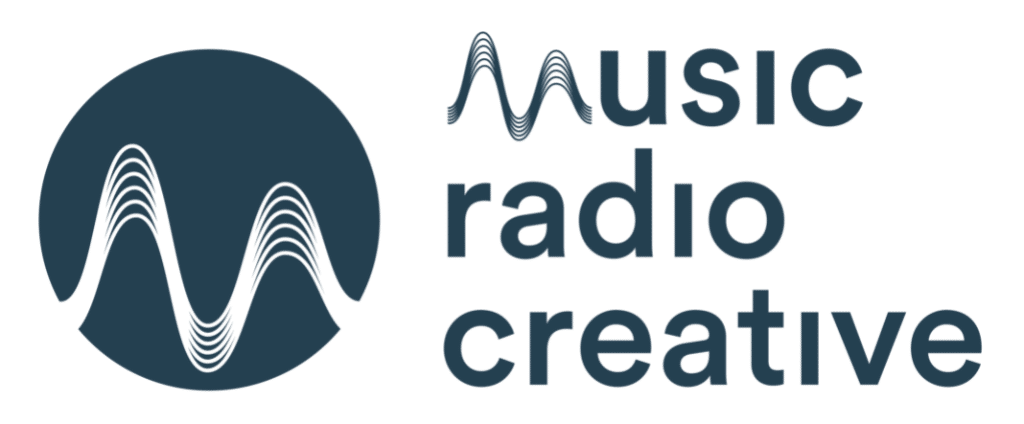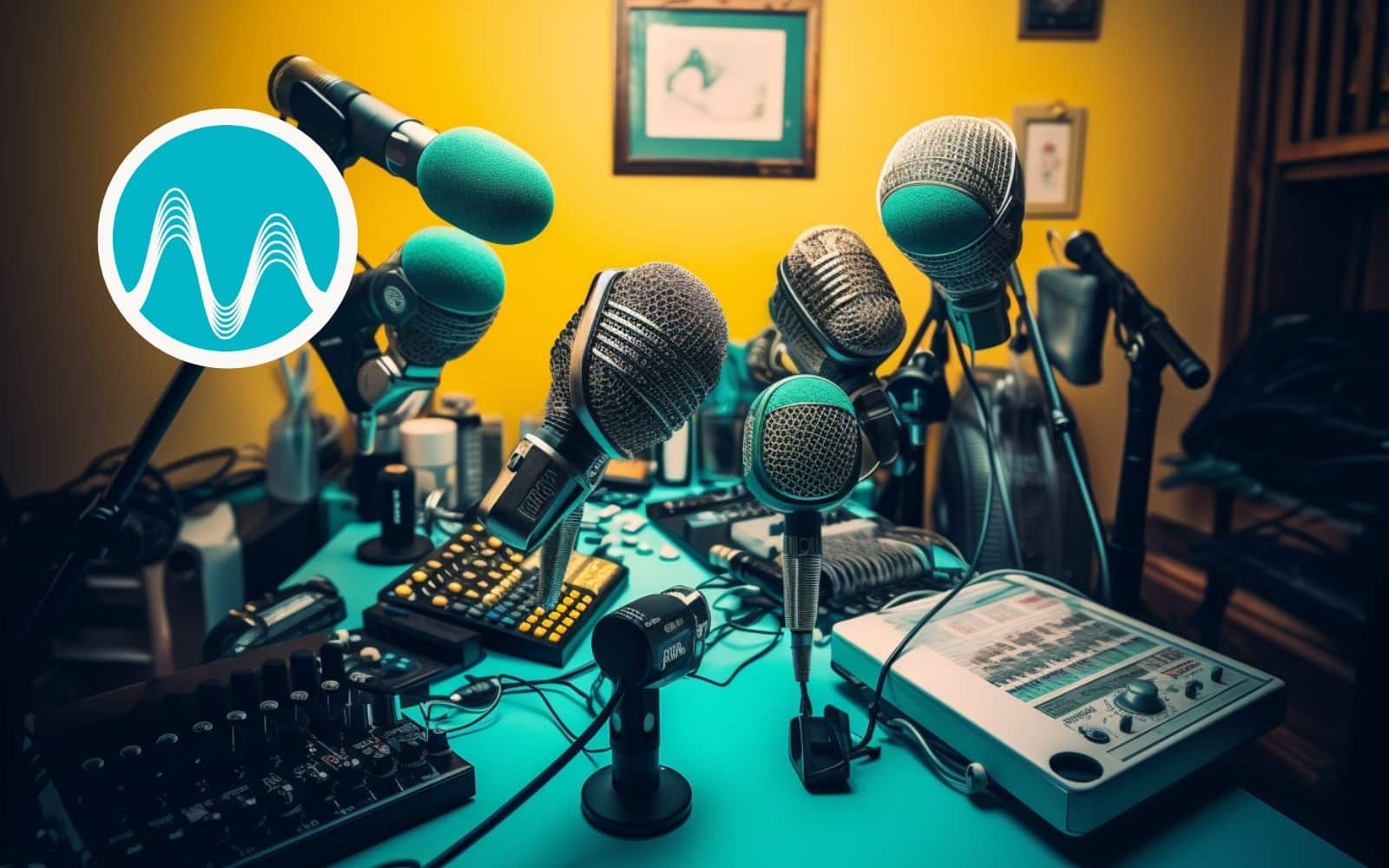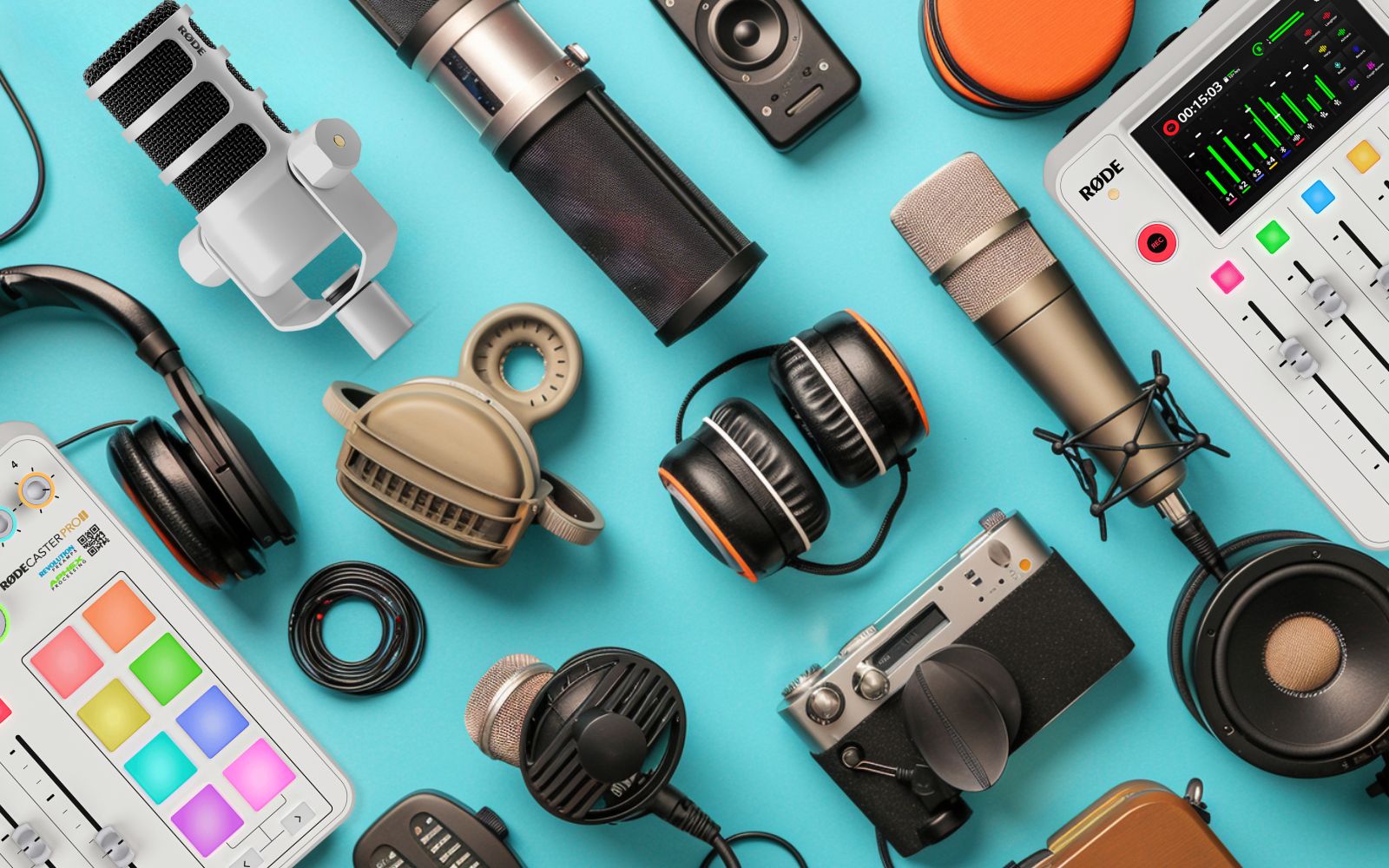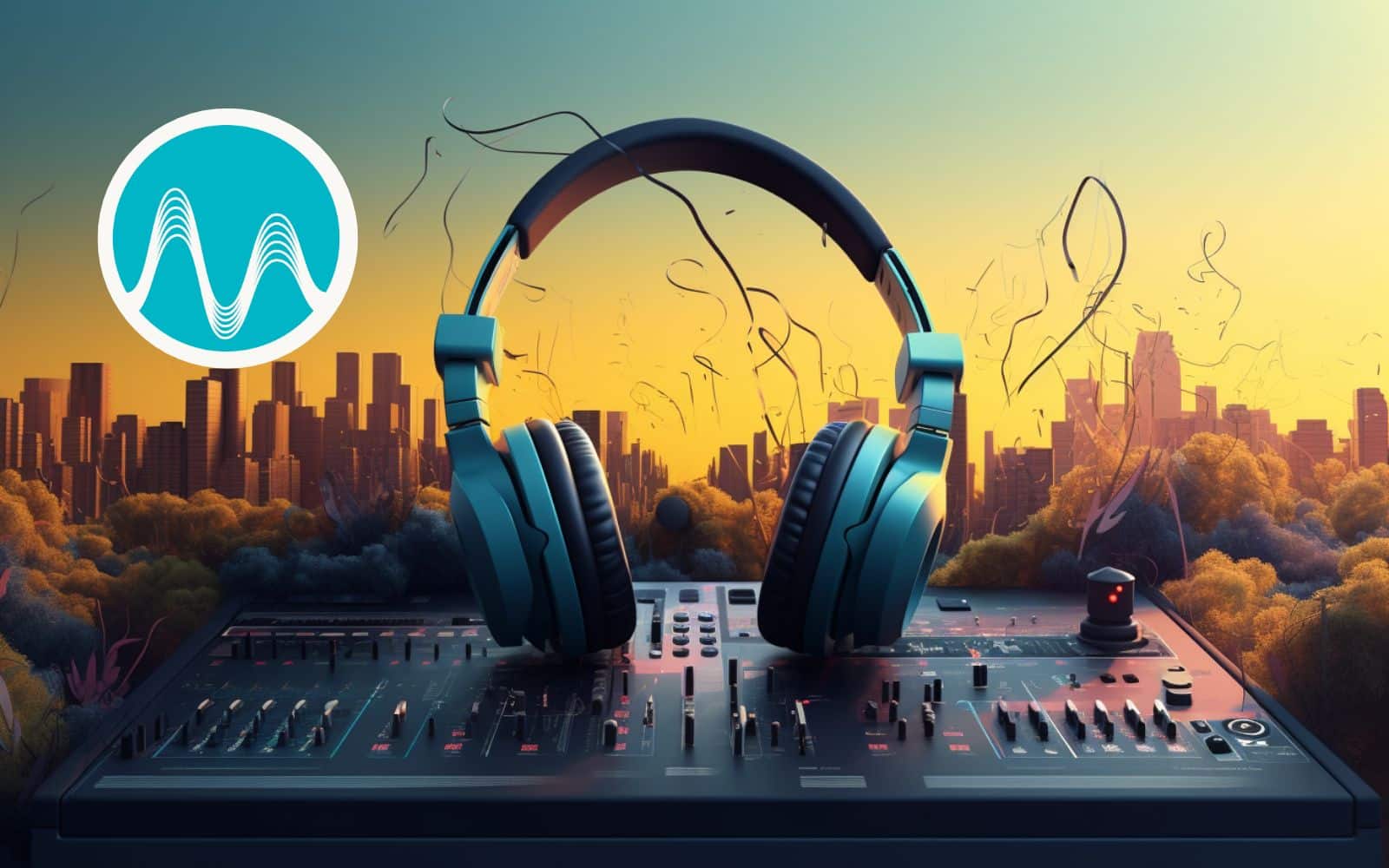In the fast-paced world of podcasting, having the right equipment is crucial for delivering high-quality audio and engaging content. As we step into 2023 and beyond, it’s time to explore the ultimate podcast equipment. This can take your show to the next level. From audio interfaces to microphones, cables to mic stands. We’ve curated a list of top recommendations that are sure to meet your podcasting needs.
Audio Interface
An essential component of any podcasting setup, audio interfaces serve as the bridge between your microphones and your computer or recording device. They play a crucial role in capturing and processing audio signals, ensuring that your podcast episodes sound professional and polished. There is a myriad of options available in the market. It’s important to choose an audio interface that meets your specific needs. In this section, we will explore some of the top audio interfaces for podcasting in 2023. Each offering unique features and advantages. Whether you’re a beginner or a seasoned podcaster. Investing in a quality audio interface can significantly elevate the overall audio quality of your show.
Scarlett 2i2
The Scarlett 2i2 remains a popular and user-friendly choice, offering excellent audio quality and ease of use.
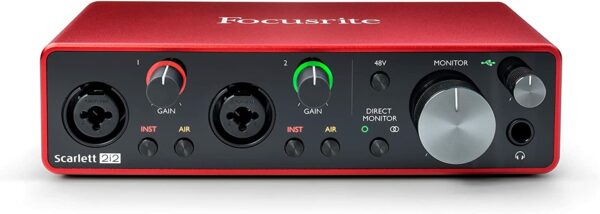
Price: £149/$189
Pros:
- Ease of use: The Scarlett 2i2 is known for its user-friendly interface, making it an excellent choice for beginners or podcasters who want a straightforward setup process.
- High-quality preamps: It features high-quality preamps that provide clean and transparent audio capture, ensuring accurate sound reproduction.
- Solid build quality: The Scarlett 2i2 is built to last, with a sturdy construction that can withstand regular use and transportation.
- Versatility: It offers a good balance of inputs and outputs, with two XLR/TS combo inputs, allowing you to connect microphones, instruments, or line-level sources simultaneously.
- USB connectivity: The USB connectivity makes it compatible with a wide range of devices, including computers, laptops, and tablets.
Cons:
- Limited I/O options: While the Scarlett 2i2 is suitable for most podcasting setups, it may lack sufficient inputs and outputs for more complex recording setups that require multiple microphones or additional audio sources.
- No MIDI connectivity: If you plan to incorporate MIDI devices into your podcasting setup, the Scarlett 2i2 does not have built-in MIDI connectivity, which may require additional equipment or adapters.
- Lack of advanced features: Compared to higher-end audio interfaces, the Scarlett 2i2 may not offer advanced features like onboard effects, dedicated headphone mixes, or digital signal processing options.
- Limited headphone output power: The headphone output of the Scarlett 2i2 may not provide sufficient power for high-impedance headphones, potentially affecting the volume and overall sound quality during monitoring.
Overall, the Scarlett 2i2 is a reliable and popular choice for podcasters due to its ease of use, quality preamps, and solid construction. However, it may not be suitable for more advanced or complex recording setups that require additional inputs/outputs or advanced features.
Motu M2
The Motu M2 is an audio interface that has gained recognition for its exceptional audio quality, versatility, and user-friendly features. Designed to meet the needs of podcasters, musicians, and content creators, the Motu M2 offers several advantages that make it a compelling choice for your podcasting setup.
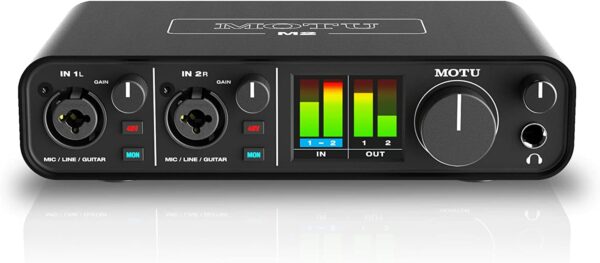
Price: £200/$250
Pros:
- Superior sound quality: The Motu M2 boasts excellent audio fidelity, thanks to its high-quality preamps and converters. It delivers clear, transparent, and detailed sound reproduction, ensuring that your podcast episodes have professional-grade audio.
- Versatility in inputs and outputs: Despite its compact size, the Motu M2 offers a range of connectivity options. It features two combo XLR/TRS inputs that can handle both microphones and line-level sources, allowing you to connect a variety of audio devices. Additionally, it has two balanced TRS outputs for connecting studio monitors or headphones.
- Low-latency performance: The Motu M2 utilizes advanced drivers and hardware design to minimize latency during recording and monitoring. This means that you can listen to your audio in real-time without any noticeable delay, facilitating a seamless recording experience.
- Robust build quality: The Motu M2 is built to withstand the rigors of regular use. Its solid metal chassis provides durability and ensures that it can handle the demands of both studio and portable podcasting setups.
- Easy-to-use interface: The Motu M2 features a simple and intuitive control panel, allowing for quick and effortless adjustments. With clearly labeled controls and LED indicators, it is easy to set the input gain levels, adjust monitoring settings, and monitor the signal status at a glance.
Cons:
- Limited simultaneous inputs: While the Motu M2 provides two combo inputs, which is suitable for many podcasting setups, it may not be sufficient if you plan to have multiple hosts or guests using individual microphones simultaneously. In such cases, you might require an audio interface with more input options.
- Lack of advanced features: The Motu M2 focuses on delivering high-quality audio and ease of use, but it may lack some advanced features found in more expensive audio interfaces. For example, it does not offer onboard effects or dedicated headphone mixes.
- No MIDI connectivity: If you plan to integrate MIDI devices into your podcasting setup, it’s important to note that the Motu M2 does not have built-in MIDI connectivity. You may need additional equipment or adapters to incorporate MIDI devices.
The Motu M2 stands out as a versatile and reliable audio interface for podcasting. Its superior sound quality, versatility in connectivity, low-latency performance, and durable build make it an excellent choice for podcasters looking for a compact yet powerful audio interface. While you may run into limitations in terms of simultaneous inputs and advanced features. The Motu M2 delivers on its core promise of delivering high-quality audio and a seamless recording experience.
RODE Rodecaster PRO II
The RODE Rodecaster Pro II is a cutting-edge podcasting hub designed to provide podcasters with a comprehensive and professional-grade recording solution. With its advanced features and intuitive interface, the Rodecaster Pro II simplifies the podcasting process, allowing you to focus on creating captivating content.

Price: £625/$800
Let’s explore some of its key pros and cons:
Pros:
- All-in-one podcasting solution: The Rodecaster Pro II combines multiple essential podcasting functions in a single device, including multitrack recording, sound effects, mixing capabilities, and phone call integration. This eliminates the need for complex setups and external equipment, streamlining your podcasting workflow.
- Excellent audio quality: With high-quality preamps, onboard processing effects, and multitrack recording capabilities, the Rodecaster Pro II delivers exceptional audio quality, ensuring that your podcasts sound professional and engaging.
- Intuitive and user-friendly interface: The touchscreen interface, accompanied by tactile controls, makes it easy to navigate and control the Rodecaster Pro II. Its intuitive layout and clear labeling allow for quick adjustments, reducing the learning curve and enhancing the overall user experience.
- Versatile inputs and outputs: The Rodecaster Pro II offers four XLR microphone inputs, allowing you to connect multiple microphones for interviews or group discussions. It also provides flexible headphone outputs, ensuring that hosts, guests, and producers can monitor the audio comfortably.
- Seamless integration and connectivity: The Rodecaster Pro II supports Bluetooth, USB, and TRRS connections, making it effortless to incorporate music tracks, conduct phone interviews, or engage with remote guests. This versatility expands your podcasting possibilities.
Cons:
- Price: The Rodecaster Pro II is a premium product, and its feature-rich design reflects in its price point. It may not be the most budget-friendly option for beginners or podcasters on a tight budget.
- Portability: While the Rodecaster Pro II is relatively compact, it may not be as portable as other simpler audio interfaces. If you require a highly portable setup for on-the-go podcasting, you might need to consider more lightweight and compact alternatives.
- Limited advanced audio processing: While the Rodecaster Pro II offers a range of onboard processing effects, it may not provide the same level of customization and flexibility as dedicated audio software. Advanced users seeking extensive control over audio processing may find it limiting.
The RODE Rodecaster Pro II is a feature-packed podcasting hub that delivers exceptional audio quality and simplifies the podcasting process. Its all-in-one design, intuitive interface, versatile inputs/outputs, and seamless integration options make it a top choice for podcasters seeking a professional-grade recording solution. However, its higher price point and potential limitations in advanced audio processing may be factors to consider based on your specific needs and budget.
Rodecaster DUO
The Rodecaster Duo is a powerful podcasting tool that offers a variety of features for creators of all levels. It has four XLR inputs, two stereo inputs, and a built-in mixer, making it ideal for recording interviews, remote guests, and music. The Rodecaster Duo also includes a number of sound effects and jingles, as well as the ability to record and edit podcasts directly from the device.
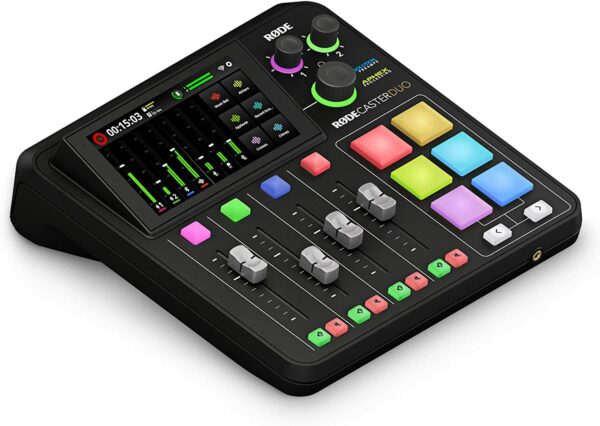
Price: £570/$700
Here are some of the pros and cons of the Rodecaster Duo:
Pros:
- Powerful features: The Rodecaster Duo offers a wide range of features that make it ideal for podcasting. This includes four XLR inputs, two stereo inputs, a built-in mixer, sound effects, and the ability to record and edit podcasts directly from the device.
- Easy to use: The Rodecaster Duo is relatively easy to use, even for beginners. The user interface is straightforward. The device comes with a number of tutorials and resources to help users get started.
- Portable: The Rodecaster Duo is a portable device that can be easily taken on the go. This makes it ideal for recording podcasts on location or at events.
Cons:
- Expensive: The Rodecaster Duo is a relatively expensive device.
- No touchscreen: The Rodecaster Duo does not have a touchscreen display. This can make it difficult to navigate the user interface for some users.
- Limited storage: The Rodecaster Duo has a limited amount of internal storage. Users will need to purchase an external hard drive or SD card to store their podcasts.
Overall, the Rodecaster Duo is a powerful podcasting tool that offers a variety of features for creators of all levels. However, it is a relatively expensive device and does not have a touchscreen display or a lot of internal storage.
Mackie DLZ Creator
This is the rising giant of 2023. The Mackie DLZ Creator, offers Automix for precise level control, a mix agent for streamlined setup, and the trust of a heritage brand. This audio interface is a professional-grade option, particularly favoured by those seeking pro audio capabilities. The Mackie DLZ Creator is a powerful podcasting and live streaming mixer. It offers a variety of features for creators of all levels. You will find it has four XLR inputs, two stereo inputs, a built-in mixer, sound effects, and the ability to record and edit podcasts and livestreams directly from the device.
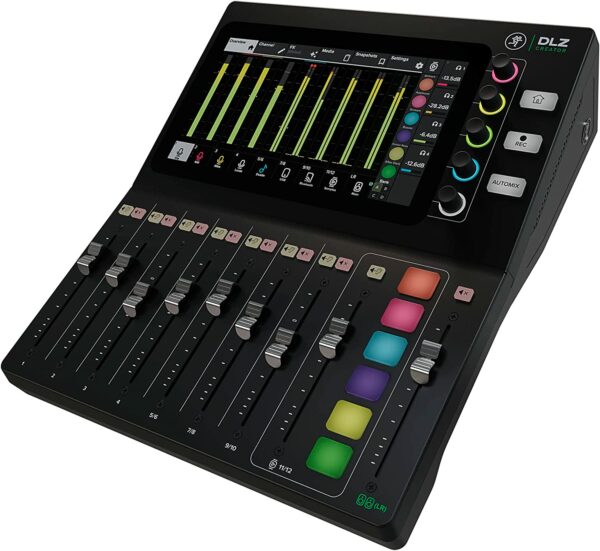
Price: £770/$850
Here are some of the pros and cons of the Mackie DLZ Creator:
Pros:
- Powerful features: The Mackie DLZ Creator offers a wide range of features that make it ideal for podcasting and livestreaming. This includes four XLR inputs, two stereo inputs, a built-in mixer, sound effects. As well as the ability to record and edit podcasts and livestreams directly from the device.
- Easy to use: The Mackie DLZ Creator is relatively easy to use, even for beginners. The user interface is straightforward. The device comes with a number of tutorials and resources to help you get started.
- Portable: The Mackie DLZ Creator is a portable device that can be easily taken on the go. This makes it ideal for recording podcasts and livestreams on location or at events.
- Touchscreen display: The Mackie DLZ Creator has a large, 10-inch touchscreen display. There is no other device with such a big display on the market. It makes navigation a breeze!
- Plenty of storage: The Mackie DLZ Creator has 256GB of internal storage. You will find this is plenty of space for recording and storing podcasts and livestreams.
Cons:
- Expensive: The Mackie DLZ Creator is a relatively expensive device. However, it offers a number of features that justify the price tag for serious podcasters and livestreamers.
Overall, the Mackie DLZ Creator is a powerful podcasting and live streaming mixer that offers a variety of features for creators of all levels.
Podcasting Microphones
When it comes to podcasting, selecting the right microphone is crucial for ensuring high-quality audio and engaging content. The microphone you choose can greatly impact the clarity, warmth, and overall sound quality of your podcast episodes. Here are some of our top choices:
Shure SM7B
Almost an industry standard, the Shure SM7B is renowned for its exceptional sound reproduction and versatility, making it an ideal choice for podcasters.
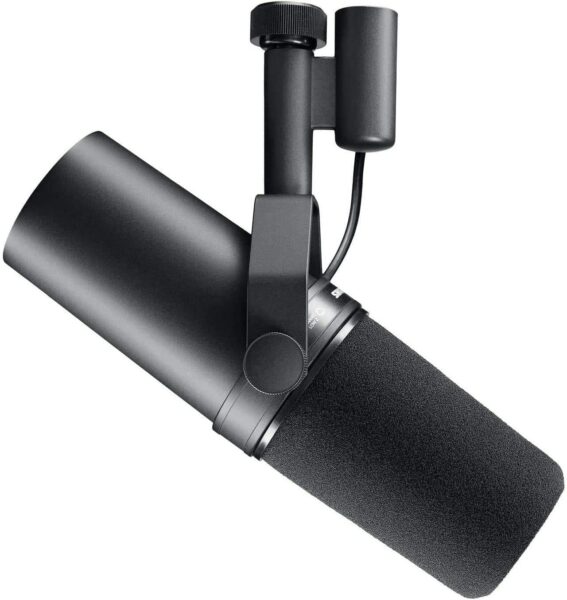
Price: £359/$450
Pros:
- Flat frequency response: The SM7B has a flat frequency response, which means that it captures all frequencies equally. This makes it a good choice for a variety of applications, including vocals, voiceovers, and music.
- High SPL handling: The SM7B can handle high sound pressure levels (SPLs), making it a good choice for recording loud sources, such as drums and guitars.
- Low noise floor: The SM7B has a low noise floor, which means that it captures sound with minimal noise. This makes it a good choice for recording in noisy environments.
- Durable construction: The SM7B is built to last, with a rugged metal housing and a cardioid polar pattern that rejects unwanted noise.
Cons:
- Pricey: The SM7B is a relatively expensive microphone.
- Requires phantom power: The SM7B requires phantom power to operate. This is not a problem for most audio interfaces, but it is something to keep in mind if you are using a mixer or other device that does not provide phantom power.
- Not as good for close-up recording: The SM7B is not as good for close-up recording as some other microphones. This is because it has a cardioid polar pattern, which rejects sound from the sides and rear.
Overall, the Shure SM7B is a versatile and high-quality microphone that is well-suited for a variety of applications. However, it is a relatively expensive microphone and requires phantom power to operate.
Shure MV7
The MV7 is a dynamic microphone, which means that it is not as sensitive to sound as a condenser microphone. This can be a good thing or a bad thing, depending on your needs. Dynamic microphones are often better for recording loud sources, such as drums and guitars, while condenser microphones are often better for recording quiet sources, such as vocals and acoustic instruments.
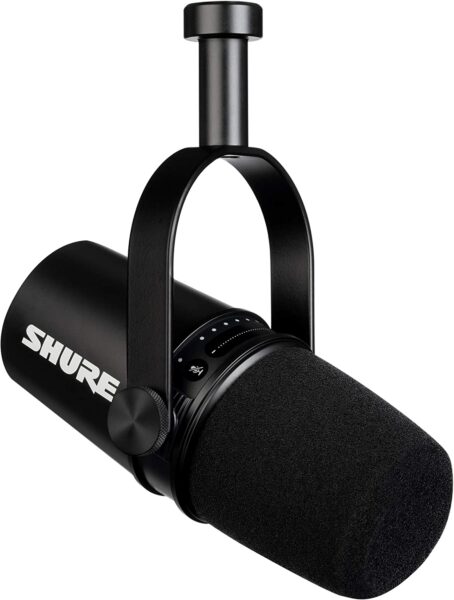
Price: £259/$350
Pros:
- Dual Connectivity: The MV7 offers both USB and XLR connections. This versatility allows you to use it as a regular XLR microphone or connect it directly to a computer without the need for an audio interface.
- Build Quality: It has a solid build quality typical of Shure products, which ensures that the microphone is durable and can withstand regular use.
- Sound Quality: The MV7 is known for its good sound quality, with a clear and well-rounded sound profile. Which makes it suitable for vocals, podcasting, and more.
- Integrated Headphone Jack: The inclusion of a headphone jack allows for real-time monitoring. This is useful for ensuring that the audio is being captured properly.
- Customizable Sound Settings: Through the ShurePlus MOTIV app, you can control aspects such as gain, EQ, and compression settings when using the microphone through USB.
- Integrated Mount: The MV7 comes with an integrated mount. Which makes it super easy to attach to a mic stand or boom arm.
- Dynamic Microphone: Being a dynamic microphone, it’s generally less sensitive to ambient noise compared to condenser microphones. Which is great for environments that are not acoustically treated.
Cons:
- Price: Some might consider the Shure MV7 to be somewhat expensive compared to other USB microphones available on the market.
- USB Audio Quality: While convenient, the USB audio quality might not be as high as when using the XLR connection, particularly for professional recording purposes.
- Size and Weight: The MV7 is relatively bulky and heavy compared to some other microphones, which might make it less portable and require a sturdier mic stand.
- Software Limitations: The ShurePlus MOTIV app is limited to USB mode and might not offer all the customization that professional audio engineers are looking for.
- Lacks Some Features of SM7B: While inspired by the Shure SM7B, the MV7 lacks some of the features and the depth of sound quality that the SM7B is renowned for, which might be an issue for audio purists.
- Sensitivity to Plosives: Some users have reported that the MV7 is sensitive to plosives (the sounds of letters like ‘p’ and ‘b’) and might require an additional pop filter for the best results.
Keep in mind that whether or not the Shure MV7 is right for you may depend on your specific use case and requirements. It’s always a good idea to compare it with other options and consider the opinions of other users and experts.
Rode PodMic
For podcasters on a budget, the Rode PodMic offers excellent value, ensuring clear and crisp audio performance.
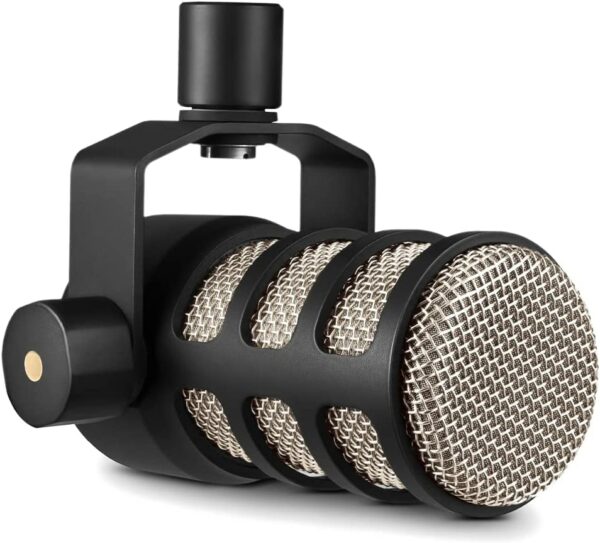
Price: £100/$120
Pros:
- Price: The Rode PodMic is relatively affordable compared to other professional-grade microphones, making it a popular choice for those on a budget.
- Build Quality: The PodMic has a solid, all-metal construction, which makes it durable and capable of withstanding the rigors of daily use.
- Sound Quality: It is known for its clear and warm sound profile that is particularly well-suited for spoken-word content, such as podcasts and voiceovers.
- Integrated Pop Filter: The PodMic features an internal pop filter that helps reduce plosives, which are the sounds that can occur when pronouncing letters like ‘p’ and ‘b’.
- Swivel Mount: The PodMic has an integrated swivel mount which makes it easy to adjust the angle of the microphone for optimal positioning.
- Dynamic Microphone: Similar to the Shure MV7, being a dynamic microphone, the PodMic is generally less sensitive to ambient noise than condenser microphones, making it suitable for environments that are not acoustically treated.
Cons:
- XLR Only: The PodMic only supports an XLR connection, meaning you will need an audio interface to connect it to your computer. This could be an additional expense if you don’t already have one.
- Weight: The PodMic is relatively heavy, which means it requires a sturdy microphone stand or boom arm to hold it securely.
- Lacks Customization Software: Unlike the Shure MV7, the Rode PodMic doesn’t have accompanying software for customization and tuning of the audio settings.
- May Require Additional Processing: Some users have noted that to get the best sound from the PodMic, post-processing or additional hardware like a cloudlifter or preamp might be needed, especially to achieve sufficient gain levels.
- Lack of Versatility: The PodMic is tailored for spoken word applications and may not be as versatile as other microphones for different types of recording, such as singing or musical instruments.
- No USB Option: Unlike the Shure MV7, there is no USB option for direct connection to a computer. This could be a drawback for you if you are looking for a simpler setup.
Audio Technica AT-2020USB
Another reliable option, the Audio Technica AT-2020USB, provides solid audio quality and is suitable for various podcasting applications.
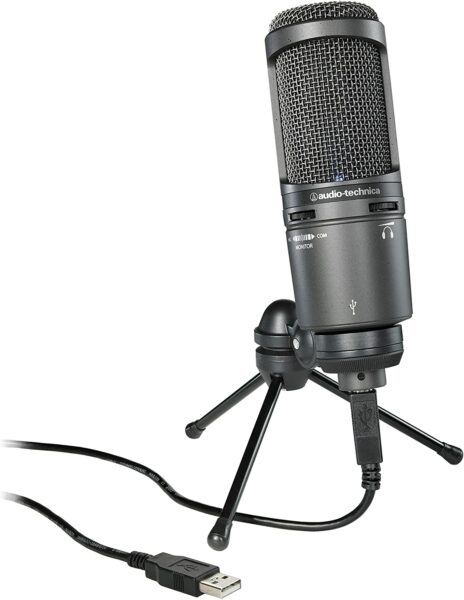
Price: £100/$120
The Audio-Technica AT2020USB is a USB version of the popular Audio-Technica AT2020 condenser microphone.
Pros:
- Plug-and-Play: Being a USB microphone, the AT2020USB can be easily connected to a computer without the need for an external audio interface. The setup is quick and simple.
- Sound Quality: The AT2020USB is known for its clear and detailed sound, making it suitable for a variety of applications. This includes: podcasting, streaming, voice-over work, and recording musical instruments.
- Portability: It’s relatively lightweight and compact compared to some other professional microphones. This makes it easier to transport or use in a limited space.
- Condenser Capsule: The condenser capsule captures a wider frequency range and is more sensitive compared to dynamic microphones. This is beneficial for capturing the nuances in voice and instruments.
- Integrated Headphone Jack: Like the Shure MV7, the AT2020USB also includes a headphone jack for real-time monitoring. This helps you to ensure the audio is being captured properly.
- Build Quality: The microphone has a solid build and feels durable, which is typical of Audio-Technica products.
- Accessories: The AT2020USB often comes with useful accessories such as a tripod desk stand, a pivoting stand mount, and a storage pouch.
Cons:
- Sensitive to Ambient Noise: As a condenser microphone, it’s more sensitive to background noises and room acoustics than dynamic microphones. This makes it potentially less ideal for untreated recording environments.
- No XLR Option: Unlike the Shure MV7, the AT2020USB does not offer an XLR connection option, limiting its use to USB only. This could be a drawback for you if you wish to use it with an audio interface.
- Lack of Onboard Controls: The AT2020USB doesn’t have onboard controls for things like gain or mute. You might find this limiting.
- Plosive Sensitivity: Like many condenser microphones, it can be sensitive to plosives. We highly recommend using a pop filter for recording voice.
- Power Requirements: Being a condenser microphone, it requires power through USB. While this is not usually an issue. It does mean it’s not as versatile in situations where USB power might not be convenient.
- Not Ideal for Rugged Use: Condenser microphones are generally more fragile than dynamic microphones. The AT2020USB may not be the best choice for situations where it might be subject to rough handling.
Cables
While cables may seem like a minor detail, using high-quality cables can enhance the overall audio experience. Consider the following brands:
a) Van Damme – Known for their exceptional quality. Van Damme cables provide reliable and high-fidelity audio transmission, ensuring clarity and durability.
b) Neutrik – As an industry-standard brand for connectors like XLR. Neutrik offers robust and reliable cable connectors, making them a popular choice among professionals.
Mic Stands
Mic stands play a crucial role in podcasting, providing stability, proper positioning, and enhancing sound quality. Choosing the right mic stand can significantly impact the overall recording experience and the clarity of your audio. Note that there are MANY cheaper options available but from experience when it comes to buying a mic boom arm. You buy cheap, you buy twice! We have decided to list only our trusted recommendations here:
RODE PSA 1+
The RODE PSA 1+ is a highly regarded microphone boom arm that could offer you an excellent stability, flexibility, and ease of use. Designed for professional podcasting and broadcasting setups, the PSA 1+ provides a reliable and convenient solution for suspending your microphone. This is our boom arm of choice.
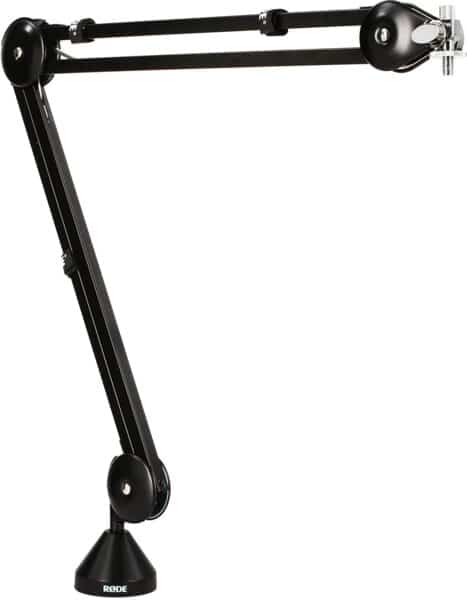
Price: £80/$100
Here’s a brief overview of its features, along with its pros and cons:
Pros:
- Solid Construction: The RODE PSA 1+ is built with robust materials, ensuring durability and long-lasting performance. Its sturdy design allows it to securely hold heavier professional-grade microphones without drooping or sagging.
- Flexible Positioning: With a fully adjustable design, the PSA 1+ allows you to position your microphone precisely where you need it. Its 360-degree rotation and horizontal reach of up to 32.5 inches offer ample flexibility to find the optimal placement for your microphone, whether you’re sitting or standing.
- Cable Management: The PSA 1+ features integrated cable management, providing a clean and organized setup. The internal cable routing helps keep your microphone cable neatly tucked away. This in turn is reducing clutter and minimizing the risk of accidental tugs or interference during recordings.
- Easy Installation: Setting up the RODE PSA 1+ is a breeze. It comes with a desk clamp that securely attaches to various desk surfaces. This is eliminating the need for drilling or permanent installation. This makes it suitable for home studios or rented spaces where you want a non-intrusive mounting option.
- Compatibility: The PSA 1+ is compatible with a wide range of microphones and shock mounts. Its standard 3/8″ thread ensures that it can accommodate most microphone models. Which allows you to adapt and use different microphones as per your preference or recording requirements.
Cons:
- Price: Compared to some entry-level microphone stands or boom arms, the RODE PSA 1+ is priced at a higher range. However, the build quality, stability, and functionality it offers justify the investment for those seeking professional-grade equipment.
- Desk Space: While the PSA 1+ provides flexibility in positioning. Its size and reach might require a sufficient amount of desk space. Ensure that you have enough room to accommodate the boom arm and its extended reach. Without interfering with other equipment or causing inconvenience.
Tabletop Stands
While not ideal for isolating table bumps and noises, tabletop stands offer portability and convenience for on-the-go podcasting. There are many choices available on Amazon, they generally don’t exceed £15/$20 mark.
Conclusion
Choosing the right podcasting kit can seem like a daunting task. Especially if you are a complete beginner in the podcasting space. Investing in these top-notch equipment options will ensure that your podcasts sound professional, engaging, and captivating. Setting you up for success in the dynamic world of podcasting in 2023 and beyond.
